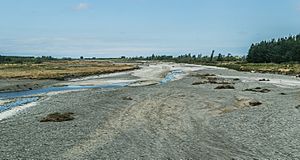Selwyn River / Waikirikiri facts for kids
Quick facts for kids Selwyn River |
|
|---|---|
| Lua error in Module:Location_map at line 420: attempt to index field 'wikibase' (a nil value).
Location of the mouth within New Zealand
|
|
| Native name | Waikirikiri |
| Country | New Zealand |
| Physical characteristics | |
| Main source | Southern Alps |
| River mouth | Lake Ellesmere / Te Waihora |
| Length | 80 km (50 mi) |
The Selwyn River / Waikirikiri is a river in the South Island of New Zealand. It flows through the Selwyn District in the Canterbury area.
Contents
About the Selwyn River
The Selwyn River starts high up in the Southern Alps. It flows east for about 80 kilometers (50 miles). The river then empties into Lake Ellesmere / Te Waihora, which is south of Banks Peninsula. The town of Whitecliffs got its name from the cliffs above the river.
Where the River Flows
For much of its journey, the river flows through wide, gravelly areas. Sometimes, especially when there isn't much rain, the river can seem to disappear. The water goes beneath the gravel bed. This often happens near State Highway 1, close to the town of Selwyn. This spot is about 20 kilometers (12 miles) from where the river meets Lake Ellesmere.
The River and Groundwater
In the hills, the Selwyn River always has water flowing. But when it reaches the flat plains, the riverbed is very porous. This means water easily leaks down into a deep underground water source called an aquifer.
Most of the river's water disappears into this aquifer within 5 kilometers (3 miles) of leaving the hills. For about 35 kilometers (22 miles), the riverbed stays dry for most of the year. However, a small part of the river has water where it joins the Hororata River. About 15 kilometers (9 miles) before Lake Ellesmere, the underground water rises back up. At this point, the Selwyn River becomes a permanent flowing river again.
River Life and Environment
When the river's surface water disappears, it affects the plants and animals that live there. Many aquatic creatures, like insects and fish, lose their homes. They have to move to other wet areas or they might not survive. Plants and algae also need water to live.
The dry parts of the Selwyn River make it hard for fish and other creatures to move. It's like a big barrier. This makes it difficult for them to travel between Lake Ellesmere and the river's starting points.
How the River Got Its Name
The Selwyn River and its gorge were named in 1849. Joseph Thomas, a chief surveyor, named them after Bishop Selwyn. Later, the name was also used for the town, the district, and a local election area.
The New Zealand Ministry for Culture and Heritage says that the Māori name, Waikirikiri, means "gravelly stream."
Images for kids
-
Result of flooding on the Selwyn River - Glentunnel, NZ. June 2021
See also
 In Spanish: Río Selwyn / Waikirikiri para niños
In Spanish: Río Selwyn / Waikirikiri para niños



